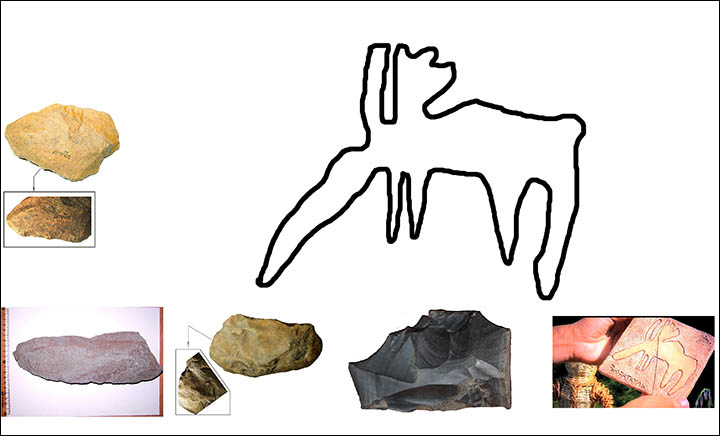 |
| A historical Google Earth image from 2007 showing the animal-shaped geoglyph in Russia. CREDIT: Image copyright 2012 Geoeye, copyright 2012 GIS Innovatsia, courtesy Google Earth. |
11 October 2012. A huge geoglyph in the shape of an elk or deer discovered in Russia may predate Peru's famous Nazca Lines by thousands of years.
The animal-shaped stone structure, located near Lake Zjuratkul in the Ural Mountains, north of Kazakhstan, has an elongated muzzle, four legs and two antlers. A historical Google Earth satellite image from 2007 shows what may be a tail, but this is less clear in more recent imagery.
Excluding the possible tail, the animal stretches for about 900 feet (275 meters) at its farthest points (northwest to southeast), the researchers estimate, equivalent to two American football fields. The figure faces north and would have been visible from a nearby ridge.
"The figure would initially have looked white and slightly shiny against the green grass background," write Stanislav Grigoriev, of the Russian Academy of Sciences Institute of History & Archaeology, and Nikolai Menshenin, of the State Centre for Monument Protection, in an article first detailing the discovery published last spring in the journal Antiquity. They note that it is now covered by a layer of soil.
Fieldwork carried out this past summer has shed more light on the glyph's composition and date, suggesting it may be the product of a "megalithic culture," researchers say. They note that hundreds of megalithic sites have been discovered in the Urals, with the most elaborate structures located on a freshwater island about 35 miles (60 km) northeast of the geoglyph [...] livescience.com/
Link 2: Hallazgo impactante en Rusia: un dibujo similar a las líneas de Nazca
Arqueólogos de la Academia Rusa de Ciencias han anunciado el descubrimiento del que podría ser el geoglifo de mayor edad hasta ahora conocido, un “monumento único en la antigüedad”: la figura de un enorme alce creada por el hombre prehistórico hace unos 8.000 años y que se encuentra en la ladera de una montaña, a 860 metros de altitud, en el Parque Nacional de la Cordillera de Zyuratkul, en el Raion de Satkinsky, en la parte sur de los Montes Urales...
Actualización 04-11-14: Children from lost civilisation 'helped build' geoglyph some 6,000 years ago
Remarkable new details about giant moose released as archaeologists confirm stone structure is world's oldest.
 |
| 8/10. Pictures: Stanislav Grigoryev |
Children were involved in the construction of a geoglyph in the Urals which was only discovered thanks to images taken from space. It predates Peru's famous Nazca Lines by thousands of years, archaeologists have announced. But they are no nearer answering why ancient man made it, nor can they yet fathom which group built the geoglyph; archeological traces found so far in the area do not show a culture with sufficient refinement.
Was it to impress the gods or did it have some other purpose?
Experts have been examining the giant moose-shaped stone structure since it was discovered in 2011 and have now confirmed it is the world's oldest.
Located near Lake Zyuratkul in the Ural Mountains, it stretches for about 275 metres and depicts an animal with four legs, antlers and a long muzzle.
Two years ago researchers said they estimated the site could date back as far as 6,000BC based on the style of the stone-working, called lithic chipping.
Now new details about the geoglyph have been released as archaeologists revealed it was most likely created between 3,000 and 4,000BC...
Actualización 06-11-14: Revelan el origen del alce gigantesco de piedra
Científicos afirman que el enorme símbolo con forma de alce descubierto en 2011 fue construido hace más de 6.000 años, y que niños de civilizaciones perdidas ayudaron a crear esta imagen enorme que se puede ver desde el cielo.
Un grupo de científicos ha establecido el origen del enorme geoglifo con forma de alce que se aprecia desde el cielo, informa 'The Siberian Times'. El geoglifo fue descubierto en 2011 gracias a imágenes por satélite de la región de los Urales cerca del lago Zyuratkul, en Rusia, y está considerado como el más antiguo del mundo. El símbolo, que se extiende por una superficie de 275 metros, fue formado con piedras y antecede a las famosas Líneas de Nazca en Perú en miles de años.
Según la investigación científica, los instrumentos encontrados cerca del símbolo indican que niños trabajaban asiduamente en el geoglifo junto con los adultos, ya que algunos instrumentos hallados fueron fabricados especialmente para que cupieran en las manos de menores. Vista desde lo alto, la enorme formación tiene aspecto de un animal parecido a un alce con cuatro patas, astas y hocico.
"Al analizar los instrumentos encontrados, cuyo tamaño varía desde los 17 centímetros y 3 kilos de peso hasta 2 los centímetros, asumimos que los instrumentos fueron usados por adultos y también por niños", afirma Stanislav Grigoryev, que encabeza la investigación del Instituto de Historia y Arqueología de Cheliabinsk (Rusia). Según el investigador "los niños no trabajaban en el geoglifo como esclavos sino que participaban en su creación para aprender los valores de la vida y unirse a algo importante para toda la población".
Originalmente se podía ver el geoglifo desde una cordillera cercana, pero ahora los arboles de esta región cubren al alce. Los científicos pretenden ahora averiguar qué civilización construyó el geoglifo y por qué.







2 comentarios:
Actualización: Children from lost civilisation 'helped build' geoglyph some 6,000 years ago
Actualización: Revelan el origen del alce gigantesco de piedra
Publicar un comentario